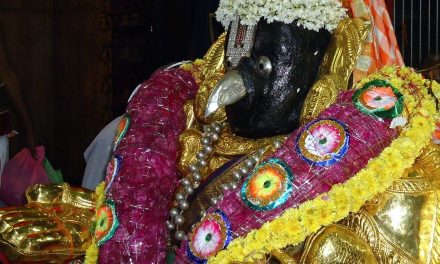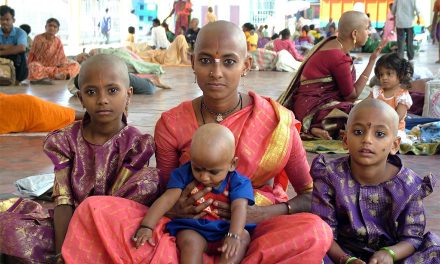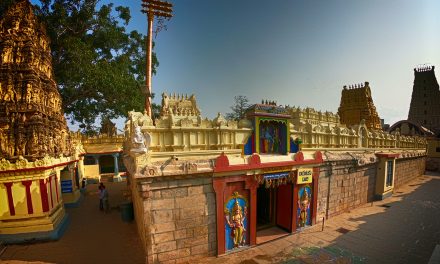Dakor, in its earlier phases as pilgrimage center in Gujarat, was famous for the Danknath temple, a place of Shiva worship. In the later phases it developed into a Vaishnavite center with the growing fame of Ranchhodraiji temple, which was built in 1772 A.D. Over the years, much has changed at Dakor, Gujarat. From a small village of Dankapur, it has now transformed itself into a major center of religious and commercial activity in the region. Dakor is home to Lord Sri Krsna Ranchhodraj, and pilgrims throng here to offer Him worship.
The form of Lord Ranchhodrai is that of the Lord Vishnu with four arms. As is usual with Lord Vishnu, he bears the conch, lotus, discus and the mace in his hands. The lower right arm is held up in the abhaya mudra – giving protection to all those who come to Him. There may be a lotus imprinted on the hand, but it is impossible to confirm that without getting really close to the Lord.
As the Lord here is worshipped more as Krishna than Dwarkadhish, i.e. younger and freer than the mature Lord of Dwaraka, His right hand is often shown to hold a flute – a favorite instrument of the Lord in His younger days. The upper right hand holds the mace, the upper left hand holds the discus and the lower left hand holds the conch. Ordinarily, it is difficult to see these “ayudhas” of the Lord in His hands. During festivals, the hands are encased in gloves of gold studded with gems.
The small shrine of the original temple is now encased in a large temple complex, which has grown up around it. The current temple complex is set in a large square setting. Four gates pierce the outer walls at the cardinal points. Various offices and storerooms are set around the outer perimeter of the temple. The actual temple is set on a high platform in a complex, set in the style of medieval temples from the region.
In times of Mahabharata, the surrounding area of Dakor constituted the ‘Hidamba’ van (jungle). It was a very dense jungle, pleasant and rich with streams and lakes. It had become an attraction for the sages to establish their hermitage for penance. Likewise, Dank Rishi had his hermitage (ashram) in this area. During penance, Lord Shiva was pleased with him and asked him to demand something. Thereupon, Dank Rishi requested Lord Shiva to remain permanently in his hermitage. Lord Shiva agreed to his request. He disappeared and left behind him His replica in the form of Ban (Ling), which is known as Danknath Mahadev. Thus in ancient times, Dakor was known as ‘Dankor’ after the name of Dankanth Mahadev. It was also known as khakhariya because of many khakhra (palash) trees in the vicinity.
Once Lord Krishna and Bhima went to the hermitage of Dank Rishi for darshan. Dnak Rishi received them and Lord Krishna, gracious as he was to his devotees, rendered homage to Dank Rishi and being pleased with his penance asked him to demand something from Him by way of blessings. Dank Rishi requested him to stay in his hermitage permanently along with Lord Shiva. For a while Lord Krishna remained silent, pondering over the demand of Dank Rishi and finally, while consenting to his request, he promised that in Kaliyuga after staying in Dwarika for 4225 years, he would come to reside in this land permanently. Thus, Lord Krishna was invited to come to Dakor.
Lord Krishna and Bhima were once going to visit the sacred thread-ceremony of Parikshit, the grand son of Arjuna and son of Abhimanyu. On their way while passing the jungle, Bhima became thirsty and was on the look out for water. Lord Krishna pointed out a basin near the hermitage of Dank Rishi. Both of them went there and quenched their thirst. Thereafter they were resting under the shades of trees. Bhima thought that if this basin was made big it would quench the thirst of wild animals, birds and human beings. With a stroke of his club, Bhima converted the basin into a big pond spreading over an enormous area of 572 acres and this is at present is known as Gomti Tank. It is situated just opposite the Ranchhodraiji Temple. It is one of the biggest village tanks in Kaira District, with masonry walls, outlets and stone steps on the sides. Even human bones are said to melt in the water of Gomti tank.
The Story of Vijayanand Bodana
The present Dakor owes its raison d’être not to Dank Rishi but to Bodana, a great devotee of Lord Krishna. In his previous birth, he is supposed to have lived in Gokul and been a cowherd called Vijayanand. On one Holi day, all the cowherds except Vijyanand worshipped Lord Krishna. His wife too worshipped Lord Krishna, but Vijayanand was proud and stayed at home. Lord Krishna came to his house in the disguise of his friend and sent him to perform ‘Holi’ puja. Coming back, he realised that his friend was none else but Lord Krishna. Next day they fought a battle of colour. Lord Krishna lost and fell into the river. Vijyanand went after him where Lord Krishna revealed his true self. Vijyanand begged forgiveness. Lord Krishna took pity on him and solaced him with a boon that he would be born in Gujarat again in Kaliyuga after 4,200 years as Vijayanand Bodana in the house of a Krishatriya, and his present wife Sudha would again be his wife, called Gangabai, when he will give them a glimpse (darshna) and relieve them by offering them emancipation (moksha).
It is said that Vijayanand Bodana, a rajput of Dakor, became a staunch devotee of Lord Krishna. He used to let the Tulsi plants grow in an earthen pot with him on his palm and used to go every six months to Dwarika to worship Lord Krishna with the said Tulsi leaves. He did this continuously, unfailingly and untiringly till he was 72 years. He then began to find it increasingly difficult to pursue this ritual. Seeing his plight, Lord Krishna told him that on his ensuing visit to Dwarika, he should bring a bullock-cart with him and Lord Krishna would accompany him to Dakor as he was exceedingly pleased with his devotion. Accordingly, Bodana went with bullock-cart to Dwarika. The hereditary priests of Dwarika (Gugli brahmins) asked him why he had brought a cart with him. Whereupon, Bodana replied that he had done so to take away Lord Krishna. Looking to the ramshackle cart, they did not believe him but nevertheless locked and sealed the sanctum sanctorum of Dwarika Temple for the night. At midnight, Lord Krishna broke open all the doors, awoke Bodana and told him to take him to Dakor. Shortly afterwards, Lord Krishna called upon Bodana to rest in the bullock-cart and drove the cart himself till reached the vicinity of Dakor. Here (near Bileshwar Mahadev on Dakor-Nadiad road) they rested for some time, touching and holding a branch of neem tree. He woke up Bodana and asked him to take over. Since that day, this neem tree is found to have one sweet branch though the rest of the branches are bitter and it forms the subject of a well-known Gujarati bhajan.
In Dwarika, the Gugli brahmins finding the image missing, chased Bodana and came to Dakor in pursuit. Bodana was frightened but Lord Krishna told him to hide the idol of the Deity in the Gomti tank and meet the Guglis. Accordingly, Bodana hid the idol and went to meet the Guglis with a pot of curd to pacify them. They became angry and one of them threw a spear at him. He fell down dead. While hurting Bodana with a spear it also hurt the image of the Deity hidden in Gomti tank and the water turned red with Lord Krishna’s (Ranchhodraiji’s) blood. It is said that even today the earth of Gomti tank where the image lay is red, while rest of the tank is of brown mud. In the midst of Gomti tank, over the place where Lord Krishna was hidden, a small temple having the Lord’s footprints is constructed and this temple is linked with the bank of Gomti Tank by a bridge.
Even with the death of Bodana, the Guglis were not appeased. Requesting Lord Krishna to return to Dwarika, they sat on the bank of Gomti tank and went on a hunger strike. At last, Lord Ranchhodraiji (Krishna) directed Gangabai, wife of Bodana, to give gold equivalent of his weight and ask the Guglis to return to Dwarika. Poor lady, the widow of Bodana, was a pauper and could not afford doing so. By a miracle, the idol became as light as a golden nose-ring (1, 1/4 val i.e.1/2 gram in weight) which was all that the widow of Bodana, Gangabai, had. The Guglis were disappointed but the Lord mercifully directed that they would find after six months an exact replica of the idol in Sevaradhan Vav (a well with steps) at Dwarika. The impatient Guglis looked for the idol sometime earlier than they were told and as a result, found an idol which, though similar to the original one, was smaller.
Pilgrims to Dakor still visit the places said to have been associated with the story viz., where the branch of neem tree under which Lord rested while coming to Dankpur subsequently turned sweet and where the idol was hidden in the Gomti tank, whereon the balance was set up to weigh the original idol which Bodana had enshrined.
Temple Festivals
About 35 temple festivals are celebrated every year. Amongst these the main festivals at Dakor are held on the Kartik, Phalgun, Chaitra and Ashwin Purnimas (full-moon days), and on each of these festivals over one lakh of people visit the Shrine.
On the New Year day i.e., first day of the bright half of the month of Kartik, Annakoot is celebrated, and that is when the largest assortment of sweets and food preparation are offered to Shri Ranchhodraiji.
Other Vaishnava festivals celebrated here include Holi, Amalaka Ekadashi, Janmashtami, Nand Mahotsav, Rathyatra and Dashera. During these festivals the Deity of Gopalaji is taken in procession on an elephant and devotees play music of high order with rhymes and rhythm.
All India Radio and other medias give coverage to Janamashtmi (Krishna janma). The festivals of Hindola and Palna are also celebrated. Every year lakhs of people from all over India and Gujarat to visit Dakor, and especially on every full-moon day (Purnima). The virtues or punya gained by visiting Ranchhodraiji temple at Dakor and having a glimpse of Lord Ranchhodrai is considered to be as equal as visiting Char Dhams.
Temple Architecture
The present temple was constructed by Shri Gopalrao Jagannath Tambwekar in 1772 A.D. at the cost of rupees one lakh. It was built with brick walls and stones pillars. It is raised on a high plinth of 168 feet by 151 feet with twelve stone steps on each side and surrounded by a spacious courtyard. It has eight domes and twenty-four turrets, the highest of them being 90 feet, making it the tallest temple in the district.
The main gate of the temple overlooks the (now crowded) banks of the lake Gomati. Silver gates are protected by the Vedic Gods – Lord Ganesha, Surya, Candra, etc., beautifully carved in high relief. The gate leads into the main courtyard. As tradition would have it, drummers sit atop the main gate in a balcony of their own. The “Nagarkhana” resonates with music during the main darshans and at Aarti times.
On entering the courtyard, one sees two tall structures used to house the thousands of lamps that are lit during the festive season, on either side. Multi-storied and multi-tiered, this type of structure is very typical of medieval Gujarati temple architecture. Back at the front gate, marble stairs lead to the main audience chamber of the temple – the Jagmohan – literally the place where the world is charmed (by the beauty of the Lord). Three large entrances allow devotes to enter the main audience chamber. The large open square structure of the audience chamber is surmounted by an imposing, glittering dome. Till recently, the dome was painted with Shri Krishna’s rasa-lila in the classical Bundi style. Recently, this has been replaced by an intricate inlay of mirror work, depicting flowers and trellis in a classical Rajput garden. Painted murals from Lord Krishna’s life adorn the walls of the audience chamber. A small section at the front of the chamber is railed off and reserved for women.
As with all classical temples, the inner sanctum of Ranchodrai is set in a straight line from the main gate of the temple. The Lord sits under a canopied pavilion in the inner sanctum. The whole structure is raised on a marble platform and the pillars of the pavilion are covered in gold. The intricately carved doors and windows to the inner sanctum are covered in silver.
There are three doors leading into the inner sanctum. The door to the right of the Lord comes in from the antechamber, leading to a special bathroom where the priests must bathe before entering the inner sanctum. Corridors from here also lead to the treasure house of the Lord – housing His innumerable jewels and clothes.
The door in front of the Lord faces the main audience chamber. At Dakor, the Lord spends as much time as possible with His devotees. The main doors to the inner sanctum are open most of the day. The doors only close when the Lord sleeps – during the afternoon and at night. The door to the left of the Lord leads to the bedchamber of the Lord – a mirrored chamber of thousand delights. Various beds, mattresses and blankets are neatly arranged in here for the Lord’s comfort. Silver and gold bedsteads are covered in soft cottons and silks. Perfumes and garlands are kept in readiness for the Lord. A small corridor leads from here to the open hall behind the bedchamber, where pilgrims perform various religious rituals to please the Lord.
As at Badrinathji in the Himalayas and Tirupati Balaji in South India, at Dakor the temple of Goddess Lakshmi, wife of the Lord, is situated outside the main temple. Lakshmiji’s temple is situated in a residential part of town at a little distance from the main temple. It is believed that the Lord visits His wife on every Friday, and on Fridays a courtly procession winds its way from the main temple down the lanes and bylanes of Dakor to unite the couple.













